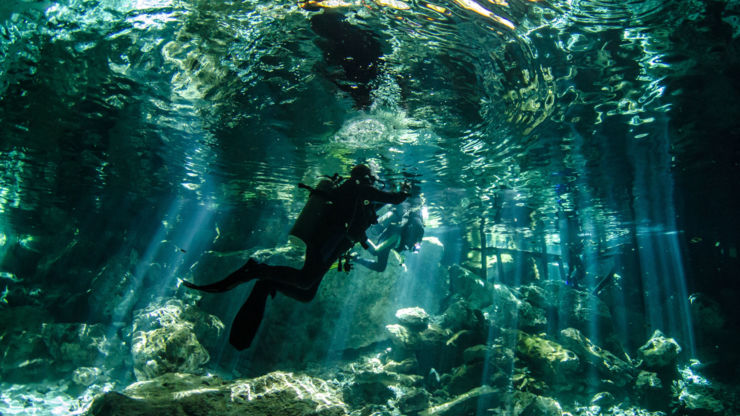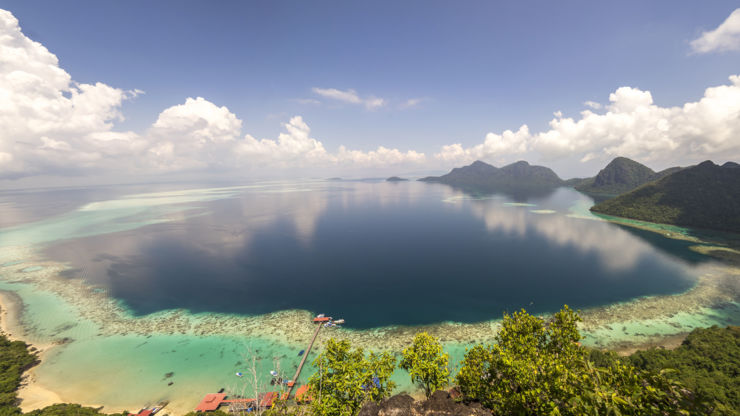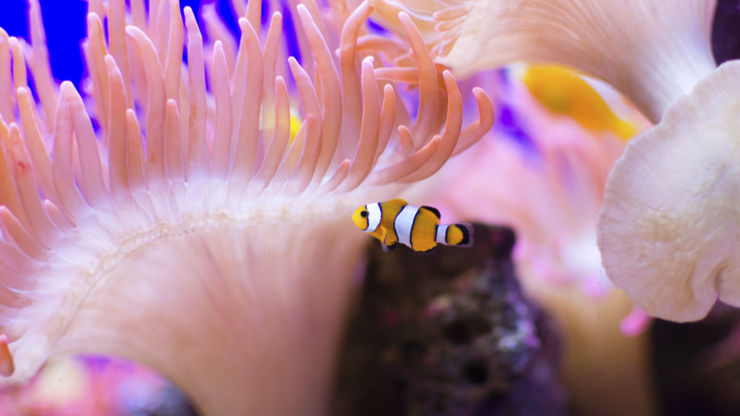There’s no better way to explore the underwater world than scuba diving. From colorful coral gardens and big, colorful fish to touring ancient underwater caves and famous shipwrecks, we’ve rounded up the best diving sites in the world.
Whether you’re a beginner or a PADI expert, there’s something truly fascinating about exploring the deep blue sea. We’ve picked out our favorite places to take the plunge, from ancient freshwater caves to coral reefs spanning miles. It really is better down where it’s wetter.
1. Cenotes in Tulum, Mexico
Mexico’s River Maya area of the Yucatan Peninsula is a mecca for divers and snorkelers alike. The area is made up of a huge limestone platform where fresh, mineral-rich water rivers run through underground cave systems. Some parts of the land collapsed during the Ice Age to form sinkholes or ‘cenotes’. In the jungles near the Mayan ruins of Tulum lie the three largest underwater cave systems: Dos Ojos, Sac Actun, and Ox Bel Ha.

If you’re a certified diver with experience you’ll have a field day on a two-tank certified cenote dive but brave beginners can get in on the action too with a two-day cenotes scuba diving tour under the watchful eye of a certified instructor. From the famous Room of Tears and the traverses of Dos Ojos to the incredible mammoth bones in Tuxchcupacha, there is plenty to see deep within the caves. Warning: this is not a dive for the fainthearted so if you’d prefer to just chill at the surface with a snorkel, you’ll be just as amazed; the water is so clear, you’ll be able to see the bottom with some cenotes as deep as 20m. We love hotel Maison Tulum which is located just a 20-minute drive from Dos Ojos and only a 10-minute walk from the Santa Clara dive shop.
2. Sipadan Island, Malaysian Borneo
The eastern coast of Borneo is one of the main reasons so many divers come to Malaysia. Living coral has been growing over an extinct volcano for thousands of years, resulting in crystal clear, warm waters and one of the richest marine habitats in the world.

Different species of turtles like greenback and hawksbill, grey and whitetip reef sharks, large schools of parrotfish and barracuda call this stunning place home. You’ll get the most out of your visit if you stay at a diving resort. Plan a dive in Borneo with a reputable tour company to get the most out of your trip.
3. Red Sea, Egypt
Part of the Great Rift Valley, the Red Sea has been hailed as one of the ‘Seven Underwater Wonders of the World’ and offers diving and snorkeling for both newbies and professionals alike. Curious historical wrecks such as the Thistlegorm, deep caves, blue lagoons, dramatic walls, and huge, colorful coral gardens make sure you’ll have an epic dive. So forget to see the pyramids, immerse yourself in Egypt’s azure coast and get your PADI while you’re there.

4. Galapagos Islands
Known as one of the ‘Seven Underwater Wonders of the World’, the Galapagos islands might seem an obvious choice for diving. With cool water and a sometimes wicked current, it’s famed for its large amount of marine fauna (with many close to the surface) and amazing underwater experiences, such as having whale sharks circle around you, swimming with equatorial penguins, and spot marine iguanas. Plan your trip and you’ll have an experience you’ll never forget.

5. Blue Hole, Belize
Declared a UNESCO World Heritage Site in 1996, the Belize Reef Reserve was a limestone cave that started forming about 150,000 years ago. Very deep at 124m and 300m wide, the Blue Hole in Belize is outlined by a lush coral reef and is inhabited by a variety of sharks, such as nurse sharks, Caribbean reef sharks, and bull sharks. Divers can also explore the stalactites and stalagmites of the ancient caverns the deeper they go. Suitable for snorkeling and intermediate level diving, the clear waters and the masses of flora and fauna will take your breath away.

The Blue Hole is located a couple of hours offshore depending on where you are staying. For a great selection of dive schools that offer Blue Hole excursions as well as restaurants, stay in the town of San Pedro on Ambergris Caye. If you don’t mind spending some extra cash, we recommend the beautiful Portofino Beach Resort which offers free snorkeling gear and kayaks to its guests, as well as that all-important welcome cocktail on arrival.
6. Cocos Island, Costa Rica
Situated in the Golden Triangle, Cocos Island is 550km off the coast of Costa Rica. Once only considered for hardcore divers, the island now attracts all sorts of scuba divers for its remote beauty and waters teeming with living things. With 20 dive sites all in the island’s compact location, there’s a site for everyone, from shallow areas and steep vertical walls to drift diving and deep dives dropping to 40m depth.

You’ll spot moray eels, scalloped hammerhead sharks, white tip reef sharks, guitar sharks, and a plethora of different species of rays – Mobula, manta, marble, and eagle rays to be precise – and that’s just a taster of what you’ll discover under the surface. As it’s protected with National Park status, there’s nowhere to stay on Cocos Island itself. Your best bet is probably to base yourself in San José at a hotel such as the Marriott Courtyard Hotel which is a pick-up point for many of the main dive tour operators going to Cocos Island.
7. Great Barrier Reef, Australia
As the only living structure that can be seen from outer space and with the world’s largest and healthiest coral reef system, diving the Great Barrier Reef should definitely be on your bucket list. Made up of 2900 individual reefs, 600 islands, and 300 coral cays, it’s the largest structure comprised of living organisms. Aboriginal people hold it as a sacred component of their spirituality whilst divers value it highly for its biodiversity. The conservation of certain areas is much-needed as a result of tropical storms, increases in carbon dioxide, and rising ocean temperatures so you must see it before it disappears.
